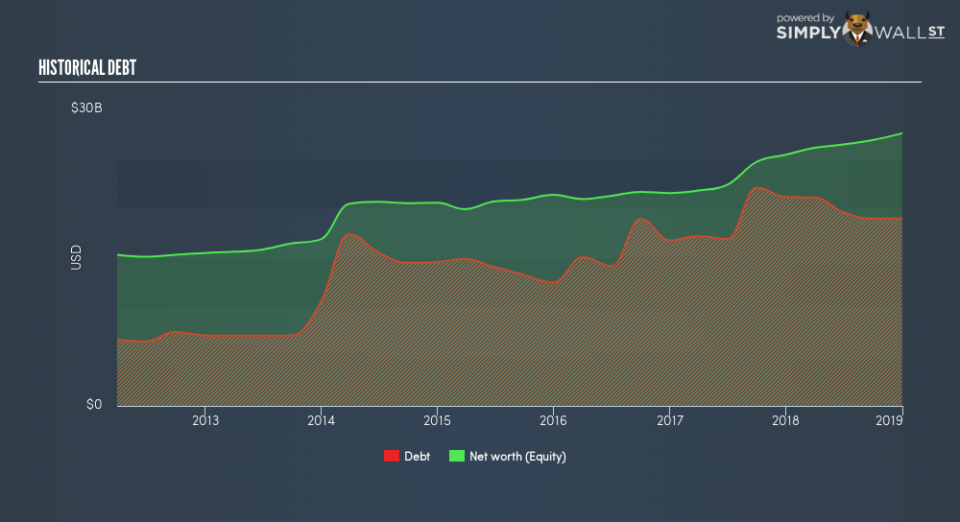Thermo Fisher Scientific Inc. (NYSE:TMO): Time For A Financial Health Check

Want to participate in a short research study? Help shape the future of investing tools and you could win a $250 gift card!
Thermo Fisher Scientific Inc. (NYSE:TMO), a large-cap worth US$100b, comes to mind for investors seeking a strong and reliable stock investment. Risk-averse investors who are attracted to diversified streams of revenue and strong capital returns tend to seek out these large companies. However, the key to their continued success lies in its financial health. This article will examine Thermo Fisher Scientific’s financial liquidity and debt levels to get an idea of whether the company can deal with cyclical downturns and maintain funds to accommodate strategic spending for future growth. Note that this information is centred entirely on financial health and is a high-level overview, so I encourage you to look further into TMO here.
View our latest analysis for Thermo Fisher Scientific
Does TMO produce enough cash relative to debt?
TMO’s debt levels have fallen from US$21b to US$19b over the last 12 months – this includes long-term debt. With this debt payback, the current cash and short-term investment levels stands at US$2.1b , ready to deploy into the business. Additionally, TMO has generated US$4.5b in operating cash flow over the same time period, leading to an operating cash to total debt ratio of 24%, signalling that TMO’s operating cash is sufficient to cover its debt. This ratio can also be a sign of operational efficiency as an alternative to return on assets. In TMO’s case, it is able to generate 0.24x cash from its debt capital.
Can TMO meet its short-term obligations with the cash in hand?
With current liabilities at US$6.2b, the company has maintained a safe level of current assets to meet its obligations, with the current ratio last standing at 1.71x. For Life Sciences companies, this ratio is within a sensible range since there is a bit of a cash buffer without leaving too much capital in a low-return environment.
Is TMO’s debt level acceptable?
TMO is a relatively highly levered company with a debt-to-equity of 69%. This isn’t surprising for large-caps, as equity can often be more expensive to issue than debt, plus interest payments are tax deductible. Consequently, larger-cap organisations tend to enjoy lower cost of capital as a result of easily attained financing, providing an advantage over smaller companies. We can assess the sustainability of TMO’s debt levels to the test by looking at how well interest payments are covered by earnings. Preferably, earnings before interest and tax (EBIT) should be at least three times as large as net interest. In TMO’s case, the ratio of 7.28x suggests that interest is appropriately covered. Large-cap investments like TMO are often believed to be a safe investment due to their ability to pump out ample earnings multiple times its interest payments.
Next Steps:
TMO’s debt and cash flow levels indicate room for improvement. Its cash flow coverage of less than a quarter of debt means that operating efficiency could be an issue. However, the company exhibits proper management of current assets and upcoming liabilities. This is only a rough assessment of financial health, and I’m sure TMO has company-specific issues impacting its capital structure decisions. I recommend you continue to research Thermo Fisher Scientific to get a better picture of the stock by looking at:
Future Outlook: What are well-informed industry analysts predicting for TMO’s future growth? Take a look at our free research report of analyst consensus for TMO’s outlook.
Valuation: What is TMO worth today? Is the stock undervalued, even when its growth outlook is factored into its intrinsic value? The intrinsic value infographic in our free research report helps visualize whether TMO is currently mispriced by the market.
Other High-Performing Stocks: Are there other stocks that provide better prospects with proven track records? Explore our free list of these great stocks here.
To help readers see past the short term volatility of the financial market, we aim to bring you a long-term focused research analysis purely driven by fundamental data. Note that our analysis does not factor in the latest price-sensitive company announcements.
The author is an independent contributor and at the time of publication had no position in the stocks mentioned. For errors that warrant correction please contact the editor at editorial-team@simplywallst.com.

